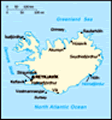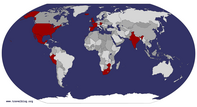Advertisement
Published: January 4th 2009
Straight from sunny Spain I headed into chilly Iceland. We arrived at Heathrow in good time although as we headed towards our gate we were a little bemused to see the people coming the opposite way wrapped up in furs and fleeces and still wearing their hats and gloves... was Iceland going to be
that cold??? We had a good flight and a very easy, if slightly surreal, experience of walking through a practically deserted airport as we arrived in Reykjavik. We took a coach to our first hotel and the tour guide gave a valient attempt at pointing out things of interest along the way. My favourite comment had to be 'And to you right is the famous Blue Lagoon. We usually get great views of it in daylight. You might be able to see it... there?... no... um, well it is there. It's just too dark.'
We arrived at our hotel which is actually university accomodation, rented out to tourists during the summer holidays. Our rooms were basic, not particularly well heated, and we had a long walk down the corridor to the shared bathrooms. I also opened my suitcase to discover that someone on our flight must have
been carrying red wine that leaked because my suitcase was wet and the top two layers of my clothes had lovely red wine stains all over them. I threw a few clothes in the sink to soak and hung as much up to air as I could... I suspect I will smell of alcohol for a few days yet though!
We awoke fairly early, took our breakfast in the university dining hall, and headed off for our first trip.
Our initial destination in Iceland had nothing to do with either ice or fire but instead was Thingvellir National Park, also known as the 'Parliament Plains'. Thingvellir is the site of the first Icleandic Parliament in the year 930 and the parliament continued until 1789. The Law Council met every summer there as well as becoming a meeting place for traders. Many important events in the history of the country have taken place at Thingvellir, such as the official adoption of Christianity in the year 1000 CE. On 17 June 1944 Iceland was proclaimed a Republic at the Althing meeting place at Thingvellir. This event marked the culmination of Iceland's struggle for independence, which began in 1262. The independent Icelandic commonwealth
was founded in 930 AD, but was lost in 1262, when Iceland swore fealty to the king of Norway. When Norway came under the crown of Denmark in 1380 Iceland followed, and remained under Denmark until 1944. The struggle for independence began in earnest in the early 19th century, and resulted in the restoration of the Althing in 1845, freedom of trade in 1854, a separate constitution in 1874, and home-rule in 1904. Finally a full independence, but under the King of Denmark, was obtained in 1918.
Thingvellir is also unique in that it lies on the site of several fault lines from the continental shift. Geographically speaking Iceland belongs to two continents, namely Europe and America. These two continents are drifting apart, due to the tectonic plates, at the ‘soaring’ speed of 2 m per century, and that process can be easily appreciated in Thingvellir. The land is constantly sinking due to the land-masses splitting apart, and thus a huge graben, or rift valley, is forming making it possible to actually walk between the two plates. Despite being in such an amazing my place my initial thought on getting of the coach was 'bl**dy h*ll it's FREEZING!! I don't
think I have enough layers in my entire suitcase.' I walked up the hill with the rest of the group, each of us turning blue at different rates. The icy wind whipped past us and we relied far more on the notice boards for information than our tour guide as we were struggling to hear anything. Still the views were breathtaking, and it was truly amazing to walk down between the tectonic plates... and not only because it got us out of the wind!! In addition to the large canyon we walked through we also saw many smaller rifts, several of which are filled with crystal clear water. One, Nikulásargjá, is better known as Peningagjá (coin fissure), as it is littered with coins at its bottom. After being bridged in 1907 for the arrival of King Frederick VII of Denmark, visitors began to throw coins in the fissure, a tradition based on European legends. Rather disturbingly, one such pool is named Drekkingarhylur (Drowningpool) where women found guilty of adultery were drowned.
After exploring the site and ensuring every member of the group had reached the same shade of blue we returned to the coach and moved on to our second
destination - Gullfoss. Gullfoss, meaning 'Golden Falls' is arguably Iceland's most famous waterfall, and is the most powerful in Europe. Gullfoss is actually two separate waterfalls, the upper one has a drop of 11 metres and the lower one 21 metres. Water flows over Gullfoss at an average rate of 109 cubic metres per second. The heaviest floods jökulhlaup (glacial outbursts) have recorded a flow of 2000 cubic metres per second. It's not surprising then that the roar of the falls is noticable long before the waterfall is in sight!
Sigurður Thórarinsson, geologist:
'These days men are prone to make the claim, and not without good reason,
that our country's waterfalls hold much of the nation's potential for the future,
Based upon values measured in kilowatt hours.
But it is also essential for our nation's welfare in the future
that we remember that the country's waterfalls also hold a potential
on which we cannot place monetary value,
that of hours of pleasure.' We followed the pathway down towards the falls, stepping carefully on the slick rocks and muddy path and struggling to hold our waterproofs closed around our cameras. Down by the falls despite the water spray
we found a few dry patches where we were able to sit in the sun that had suddenly decided to appear and recover from our Thingvellir chill. After some time we walked up to the view the falls from above and make our way to the log cabin restaurant at the top. We passed the monument of Sigríður, the young woman who is best known for her efforts in preserving the falls for the Icelandic people and laying the first pathway to the falls. Sigríður was born at Brattholt, an isolated farm near the falls, on 24th February 1871. At the turn of this century efforts began to acquire the rights to waterfalls and rapids in Iceland for industrial and hydroelectric purposes, often by agents for foreign enterprises. Early in 1907 an Englishman sought to purchase Gullfoss. He offered to pay a price of ISK 50 000, a sum equal to fifty times the assessed value of the farmhouse at Brattholt. Tómas, the farmer of Brattholt and Sigríður's father, replied "I won't sell my friend." Sigríður went on to fight the cause and protect the falls from being sold to foreign companies. Ultimately Einar Guðmundsson, who was born in 1904
and fostered by the family at Brattholt, purchased the Brattholt property from Sigríður Tómasdóttir in 1939. In 1975 he wrote the Icelandic Nature Conservation Council a letter offering to make them a gift of all the land surrounding the falls which the Council wished to declare a nature reserve.
The uphill walk gave us excellent views of the glacier visible between the mountains, and as we walked to the restaurant we saw our first Icelandic horses in the meadows.
After lunch we set off to visit Geysir, the third 'attraction' in Iceland's 'Golden Circle'. The first tales of the Great Geysir are from the year 1294 when a powerful earthquake shook the southern lowlands of Iceland and changed the geothermal area in Haukadalur valley. In written annals tales report that "large hot springs" were formed, now thought to indicate that the hot springs started to spout. The name 'Geysir' comes from the Icelandic verb gjósa, "to gush" and from there the common term 'geyser' has been applied to all similar spouting springs around the world. Geysers happen in geothermal areas when water in hot springs reaches temperatures of more than 100°C causing them to errupt. Geysir’s eruption occurs when
boiling water within the geyser, trapped by cooler water above it, explodes, forcing its way to the surface. Geysers errupt because the thermal water ascending through their channels boils at some depth below the surface. As the water boils it converts into steam, and as the steam occupies far greater volume than water, the water in the channel above is thrown high up into the air.
At one point Geysir used to errupt several times a day, sometimes for an hour at a time, the water reaching heights of 60 metres. In more recent times Geysir has stopped errupting so frequently. However, the nearby geyser Strokkur (meaning 'churn) errupts around every five minutes and reaches heights of around 20 metres making it much more tourist friendly. We stayed to watch the geyser errupt a few times and walked around the other geothermal springs, then it was onto the next guesthouse for the night. Our guesthouse was again basic, but very comfortable and surprisingly shared bathroom facilities seem to mean we all spend a lot more time standing around in corridors getting to know each other rather than all retiring to our individual rooms. Dinner was in a nearby restaurant which we all walked to. The town seemed pretty dead. I realise the weather isn't fantastic but I find it strange how few people we see - we passed a children's playground with no-one on it, just empty swings moving in the wind under a grey sky - ever so slightly eerie! On reaching the restaurant we finally found signs of life - many of the locals were gathered in the pub for a drink. The back room was reserved for our group and for the most part we swapped travel stories over dinner.
Advertisement
Tot: 0.171s; Tpl: 0.012s; cc: 38; qc: 148; dbt: 0.0931s; 1; m:domysql w:travelblog (10.17.0.13); sld: 1;
; mem: 1.6mb














JintysJourneys
Jeannie
Beautiful verse and photos!
It's amazing how you can make the same day so much more interesting. Thanks for the details and beautiful photos.